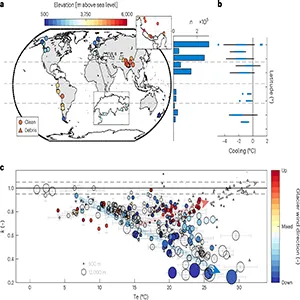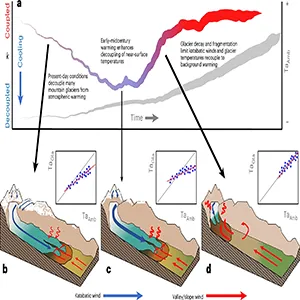
Glaciers are breathing their own cold air for the last time before disappearing
Glaciers cool the air that brushes over their surfaces today, but that buffer has a short life. A global study finds the effect will peak in the 2030s, then fade as the ice retreats.
The team showed that air just above ice warms about 0.83 degrees Celsius for every 1 degree rise (1.5 degrees Fahrenheit for every 1.8 degree rise) in nearby free air. That slower warming buys time in some valleys, but it is already running out.
How glaciers cool air around them
The work was led by Thomas E. Shaw, a glaciologist at the Institute of Science and Technology Austria (ISTA). His research focuses on glacier microclimates and how warming shifts mountain energy and water.
On warm days, dense surface air slides downslope as katabatic winds – cold, gravity-driven flows that spill into valleys. That downhill drain means that glaciers can cool air in the landscape for hours at a time.
The difference between air over ice and air off ice is called temperature decoupling. It is a measure of how strongly the glacier surface resists ambient warming. When decoupling is strong, the near-ice air warms more slowly than the free atmosphere.
“We call the difference in temperature ‘decoupling,’ because it seems at odds with the warming of ambient temperatures,” said Shaw. This counterintuitive gap highlights how glaciers can briefly resist, but not escape, the planet’s accelerating heat.
Long glaciers cool air best
Researchers compiled 3.7 million hourly observations from 350 weather stations on 62 glaciers across several continents.
They tracked how near-ice air responded to changes in surrounding temperature, humidity, wind, and glacier size.
Across the sites, the model captured regional patterns without leaning on rare, perfect datasets. It found that humidity, glacier length, and local wind exposure matter most for how strong the cooling can get.
Independent research shows glaciers lost roughly 267 gigatons of ice per year from 2000 to 2019. That melt supplied about one fifth of the observed sea level rise in that period.
These losses set the stage for the result that matters here. A shrinking glacier cannot maintain the same chill, so its low-level cooling gradually weakens.

Why this cooling fades
The cool layer above ice is a shallow boundary layer, a thin band of air that directly touches the surface. As glaciers thin and fragment, that band becomes patchy and short lived.
Many low elevations now carry a debris mantle, a blanket of rocks on ice that flips the usual heat exchange by warming the surface. Debris slows melt in some cases but also suppresses the cool air drain that kept valleys temperate.
Stronger synoptic winds – broad scale airflow that sweeps across mountain ranges – can scour away the glacier’s chilled layer. Once that happens, the air over ice feels more like the air over bedrock.
In some basins, daytime upslope winds rise over shrinking ice and erase the cold drain. That change nudges ice temperatures back toward a one-to-one match with the surrounding air.
What models project next
As the century advances, the model’s sensitivity rises because glaciers lose the very geometry that sustained their ability to cool air.
By mid century, in many regions, the cool layer will weaken enough that air over ice will track the temperature of the free atmosphere more closely.
Global projections indicate that, even if the world holds warming to 1.5 degrees Celsius, about half of all glaciers by number could disappear this century. With higher warming, losses climb and the decoupling buffer erodes even sooner.
The analysis also points to regional contrasts worth attention. Humid, calm summers over long glaciers can still produce strong decoupling for a while, whereas small, windy glaciers recouple faster.
The statistical framework explains roughly 60 percent of the variability in this cooling behavior. That performance is strong for a global problem with sparse measurements and rugged terrain.

What this means for people
Mountain water towers support drinking water, farming, and hydropower for about 1.9 billion people upstream and downstream. The weakening of the glacier chill changes not just melt rates, but also seasonal timing of runoff.
In the short term, the lingering cooling can mislead local planners who compare valley temperatures with long term records. Conditions near big glaciers may look milder for a few seasons even as the ice quietly loses volume.
The results argue for realistic water plans that assume continued ice loss, not tech fixes that cover glaciers or seed clouds. Those expensive patches cannot rebuild the geometry that sustains the chill.
Field data still matter because the thin, cold layer lives meters above the surface. New stations, better wind measurements, and careful mapping of debris will sharpen these forecasts where people need them most.
From microclimate to policy
Cooling today does not mean safety tomorrow. As decoupling wanes, melt rates respond more directly to each hot spell and each warm night.
Emergency managers should watch for shifting hazards as formerly cool valleys heat up faster in summer. That change can alter glacier lake stability, snow line height, and late season streamflow.
Modelers need to move beyond fixed relationships that treat glacier air like valley air. Updating glacier models with dynamic decoupling can minimize bias in melt estimates and improve water forecasts.
None of this changes the central driver. Cut greenhouse gas emissions, and the world reduces the heat that pushes glaciers past their very last breaths of cold air.
The study is published in Nature Climate Change.
—–
Like what you read? Subscribe to our newsletter for engaging articles, exclusive content, and the latest updates.
Check us out on EarthSnap, a free app brought to you by Eric Ralls and Earth.com.
—–













